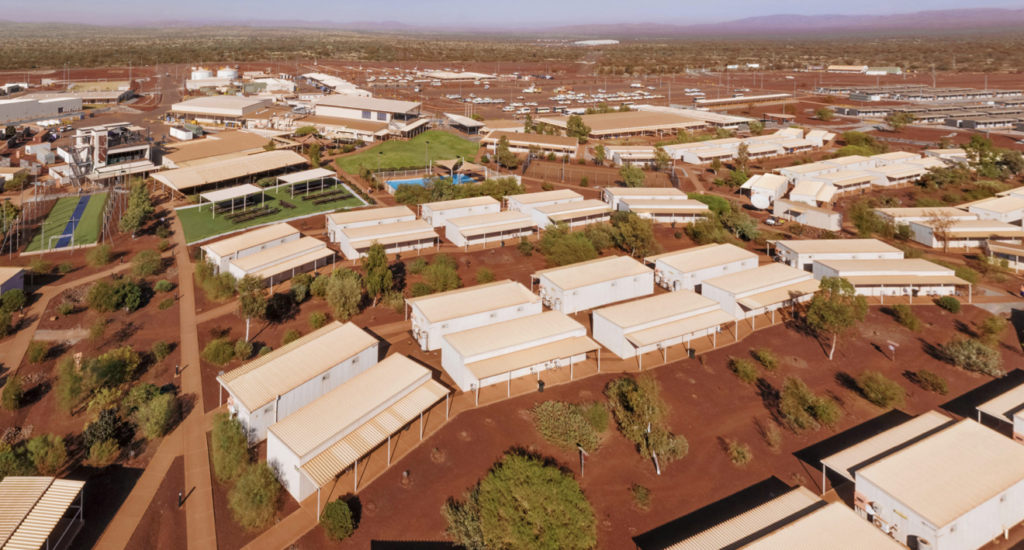Iron ore miners lure workers to outback with resort-style living

In the outback’s blistering-hot mining sites, the hours are long and the flies relentless. Now, in a bid to attract skilled workers and overcome a labor supply crunch, Australia’s iron ore companies are turning to Olympic-sized swimming pools, virtual golf arcades and fine dining.
When production starts at Mineral Resources Ltd.’s Ashburton iron ore hub around mid-2023, staff will be offered what it calls resort-style accommodation twice the size of the industry average, featuring a queen-sized bed, kitchen and lounge areas. And to overcome the strains of working remotely, a full-time mental health consultant will be on hand.
“We want to figure out how to make sure we keep the people that are working for us with us until they retire,” the company’s chief executive, Chris Ellison, said.
Meanwhile, the mining giants are also upping their game. BHP Group’s South Flank, which started production in June, features a worker village with a pool, tennis and squash courts, an indoor golf range and a range of bars and restaurants.
A recent report showed Western Australia’s resources industry needs to attract as many as 40,000 extra workers over the next two years
And Rio Tinto Group is seeking workers for its $2.6 billion Gudai-Darri project, due to start early next year, promising them comfortable living and high-speed connectivity at a site where workers will “genuinely respect each other.”
It’s a far cry from the industry’s traditional image of so-called fly-in, fly-out workers — flown in to work at mines in the desert for weeks at a time — being offered accommodation in sites resembling testosterone-fueled, heavy-drinking boot-camps, and sleeping in tiny rooms known as dongas after grueling 12-hour shifts.
The industry is also trying to clean up its sites after coming under attack due to sexual harassment claims made by women. BHP fired dozens of workers after it verified the claims, including substantiated allegations of rape. Rio also responded with steps to improve safety for female workers at its mines, including a buddy system, greater supervision and training, shorter rosters and a four-drink daily limit on alcohol consumption. BHP also has a four-drink cut-off at its sites.
“We’re trying to soften the sites down to attract a more diverse workforce,” Ellison said.
Mining companies know the ability to attract workers to their sites, and then keep them, is crucial. Despite an historic crash in iron ore prices this week to a 16-month low of $90, major miners like BHP and Rio still profit given their cost of production can be less than $20 per tonne.
They’re also used to volatile prices swings, so their hunt for talent is unlikely to change for now. Iron ore is responsible for about a third of Australia’s export revenue, or a record A$152 billion ($110 billion) in the year to June 30. while the industry employs around 280,000 people.
A recent report showed Western Australia’s resources industry needs to attract as many as 40,000 extra workers over the next two years or risk delays and potential postponement of some A$140 billion in projects. That challenge has been further complicated by the state’s border closures to keep out covid-19, while workers are also often headhunted to work in high-skilled industries such as tech and finance, despite being offered wages around double the national average at the mines.
For Mineral Resources, it’s not only about attracting and keeping the best workers: Ellison says it’s just as important to provide a safe and comfortable environment which supports the mental well-being of employees. The company is breaking the mold by planning to build accommodation to suit couples and families, seeking to get them to permanently reside and play an active part in the local community.
Still, the bulk of Western Australia’s mining-site workforce is destined to remain tied to their homes and families based hundreds of miles away, and from whom they need to remain physically distanced from for sometimes weeks at a time. Mineral Resources’ head of mental health, Chris Harris, said fly-in, fly-out workers suffered twice as much psychological distress as other Australian workers.
“Some of those challenges are just the nature of sector,” Harris said. “The question is: how do we support people to navigate those challenges?”
(By James Thornhill)
More News
Trump planning to stockpile deep-sea minerals to counter China: FT
April 13, 2025 | 07:56 am
Goldman Sachs upgrades gold forecast again to $3,700
April 12, 2025 | 08:05 pm
{{ commodity.name }}
{{ post.title }}
{{ post.date }}




9 Comments
Gareth Jones
What a joke. I am at Gudai Darri, the food is crap especially the crib choice. Never had my room cleaned on time in 5 swings. Have had to goto the office and ask them to do the job they are contracted to do and I am not alone. I will never come back to another Sodexo run camp. Why is it blokes would rather drink 12 cans instead of going to dinner. RIOs fault they chose the lowest price and dont oversee the contract
Mark
I’m wondering if this is a joke, I used to work at South flank now I’m at koodaideri and in my 15 years working FIFO nothing has changed, most camps the food is terrible rooms can stink and sometimes your bed has hairs or scabies it’s hard to sleep with people drinking and playing music outside your room people fight , they talk about a pool and this or that but your working all day in the sun at the end of the day your tired and just want to sleep there’s so much else I could say but what’s the point nothing ever changes they just have more meetings and talk about it then it’s the same
Ernesto A. Ayudan, Sr.
Thank you for keeping us updated
David
Thanks, interesting insight into remote worksite communities in the mining sector
Carol
Omfg these companies have NO IDEA ABOUT MENTAL HEALTH! ABOUT HUMAN INTERACTION! ABOUT THE AUSTRALIAN WAY. THEY RE TO BUSY GIVING THESE WORKERS TO MUCH COMFORT! LITTLE WORK? NO PEOPLE SKILLS LET ALONE RESPECT FOR THOSE WHO ACTUALLY WORK.
WHILST THEY DO THERE THING, EARN THERE BUCKS, THEN GO BACK TO THEIR RESORT, THERE ARE CLEANER CHEFS AND KITCHEN STAFF WORKING THEIR GUTS OUT TO THESE !!
“” PEOPLE “” THAT ON A DAILY BASIS DISRESPECT THOSE WHO GET LESS THAT $25 HR AFTER TAX WORK 2/1 ALSO AWAY FROM LOVE ONES AND THEIR PETS.
IM SORRY YOU GO AWAY TO WORK!! NOT TO WORK OUT AT THE GYM. GET YOUR MUSCLES THE REAL MANS WAY!!! BY WORKING, BY EARNING THAT BIG ASS PAY THAT THE REST OF US GET PISSED ON! TAKEN FOR GRANTED TREATED LIKE YOUR MOTHERS.
IM DONE BEING DISRESPECTED BY SELF CENTRED MINERS AND THEIR COMPANIES.
MENTAL HEALTH ISSUES ARE BECAUSE OF ALL THOSE BIG MINING COMPANIES AND THE LIKES OF THOSE CONTRACTORS WORKING FOR THEM.
Nick
I’ve been a chef for 35 years. During that time I was head chef of a good London restaurant, I’ve worked at 5 star International hotels in Sydney, Cairns and the UK. I have also spent 3 years working in Antarctica and 6 years in Australian mine sites. Never in my life have I experienced such a toxic environment as those 6 years, mostly in WA with ESS, and Queensland with Morriscorp and Sodexo. I’m used to 70 – 80 hour weeks. I’m not used to being spat at, cursed and threatened. When you give ridiculous money to young men who have no education and massive egos what do you expect? I worked on Barrow Island for 4 years. And the food was terrible. The ingredients were often off. The meats were of awful quality and the rules were simple – overcook everything. They are are terrified of a food poisoning outbreak in a camp where everyone lives close quarters. No wonder everyone was depressed, angry, irritable etc. I used to dread the flight to work. Literally, dread. The fault is with the mining companies who on one hand pay a couple of dollars spend on ingredients per miner, while on the other hand demand top quality meals, which they’re not going to get. You can’t build a Rolls Royce out of second hand Ford escort parts. And more fault lies with the catering companies who expect hours of unpaid overtime, with no breaks, yet trumpet their commitment to health and safety. I regularly worked 11 or 12 hours on my feet without a moment’s rest, on dangerous equipment like deep fryers and meat slicers. Total joke, they only care about profits.
Andrea Madeley
Thank you for your insight. It explains a lot.
Carlos Gardel
I have been all over the world on minesites and I have to say this is bullshit. Nothing has changed. I know the article referrs to WA but the rule is throughout Australia and other parts of world mine site camps and kitchens are complete shit where the poor people serving the food are serving up poor quality stuff because the mining companies dont want to pay for it. OIl and gas projects are the opposite in that they really take care of their people. I have heard that many times. I was on a project in Peru once and the food was so bad I ended up getting muscle cramps from lack of nutrition. How much can a guy go on a handful of rice and 1 chicken leg. The fault is with the mining companies. In next few years there will be many people who will have left the mining industry never to return. Camps and Camp food are a big reason why. And I agree with the comments here on the people who work in kitchens. They are just trying to make a buck often trying to make decent food from shit ingredients.
Toad
I have worked in the mining industry for over 15 years and have generally found the camps to be good. The mining companies can put as many good facilities in place, but workers can’t fully enjoy them when you are pushing them to work over 12 hours a day with long commutes from camp to site and back. There isn’t many daylight hours to unwind when you need to get up at 4:30 am to get ready, jump on the bus at 5:15am to start at 5:30 am and getting back to camp close to 7pm. The companies try and squeeze every minute out of workers for production, while not listening to the true causes of mental health issues.
The amenities staff the forgotten people by the mining companies and in my opinion are unpaid and underappreciated. They are expected to work long hours, put up with bad behaviour while having to try and be creative with tight budgets.